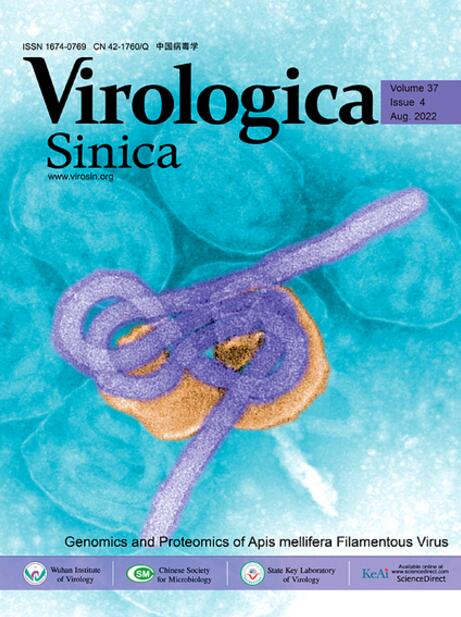2016-2020年华南地区人副流感病毒流行病学及分子特征分析
IF 4
3区 医学
Q1 Medicine
引用次数: 0
摘要
人类副流感病毒(HPIV)是急性呼吸道感染(ARI)中常见的病毒病原体。我们的目的是描述ARI患者HPIV的流行病学和分子特征。这项横断面研究使用了2016年至2020年间中国南方9696名ARI患者的呼吸样本。所有样本采用实时定量聚合酶链反应分析,以确定HPIV和其他常见呼吸道病毒的存在。进行描述性统计以确定HPIV的时间和人群分布。对hpiv3阳性标本的HN基因进行全长测序并进行系统发育分析。共有577例(6.0%)患者HPIV检测呈阳性,HPIV3为主要血清型,占病例的46.8%。值得注意的是,这些hpiv阳性病例中66.0%是0-2岁的儿童。2016-2020年HPIV感染率呈下降趋势,峰值发生变化。咳嗽、发热、咳痰和鼻漏是hpiv阳性患者常见的呼吸道症状。以肺炎为主(63.4%)。人鼻病毒(HRV)和人冠状病毒(HCoV)是hpiv阳性病例中最常见的合并感染病毒,分别占20.1%和14.4%。系统发育分析显示,HPIV3的优势谱系为C3f(86.0%),其次是C3a(8.0%)、C3d(4.0%)和C3b(2.0%)。这些发现有助于更好地了解HPIV的流行病学,并改善中国南方地区预防和控制HPIV感染的公共卫生策略。本文章由计算机程序翻译,如有差异,请以英文原文为准。
Epidemiological and molecular characteristics of human parainfluenza virus in southern China during 2016–2020
Human parainfluenza viruses (HPIV) are common viral pathogens in acute respiratory infection (ARI). We aimed to describe the epidemiological and molecular characteristics of HPIV from ARI patients. This cross-sectional study was conducted using respiratory samples from 9,696 ARI patients between 2016 and 2020 in southern China. All samples were analyzed by quantitative real-time polymerase chain reaction to determine the presence of HPIV and other common respiratory viruses. Descriptive statistics were performed to determine the temporal and population distribution of HPIV. The full-length hemagglutinin-neuraminidase (HN) gene of HPIV3-positive samples was sequenced for phylogenetic analysis. A total of 577 (6.0%) patients tested positive for HPIV, with HPIV3 being the predominant serotype, accounting for 46.8% of cases. Notably, 66.0% of these HPIV-positive cases were children aged 0–2 years. The prevalence of HPIV infections showed a decreased trend and altered peak during 2016–2020. Cough, fever, sputum production, and rhinorrhea were common respiratory symptoms in HPIV-positive patients. The majority of cases had pneumonia (63.4%). Human rhinovirus (HRV) and human coronavirus (HCoV) were the most common coinfection viruses in HPIV-positive cases, with proportions of 20.1% and 14.4%, respectively. Phylogenetic analysis revealed that the predominant lineage of HPIV3 was C3f (86.0%), followed by lineage C3a (8.0%), C3d (4.0%), and C3b (2.0%). These findings help to better understand the epidemiology of HPIV, and improve public health strategies to prevent and control HPIV infections in southern China.
求助全文
通过发布文献求助,成功后即可免费获取论文全文。
去求助
来源期刊

Virologica Sinica
Biochemistry, Genetics and Molecular Biology-Molecular Medicine
CiteScore
7.70
自引率
1.80%
发文量
3149
期刊介绍:
Virologica Sinica is an international journal which aims at presenting the cutting-edge research on viruses all over the world. The journal publishes peer-reviewed original research articles, reviews, and letters to the editor, to encompass the latest developments in all branches of virology, including research on animal, plant and microbe viruses. The journal welcomes articles on virus discovery and characterization, viral epidemiology, viral pathogenesis, virus-host interaction, vaccine development, antiviral agents and therapies, and virus related bio-techniques. Virologica Sinica, the official journal of Chinese Society for Microbiology, will serve as a platform for the communication and exchange of academic information and ideas in an international context.
Electronic ISSN: 1995-820X; Print ISSN: 1674-0769
 求助内容:
求助内容: 应助结果提醒方式:
应助结果提醒方式:


